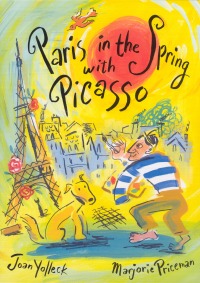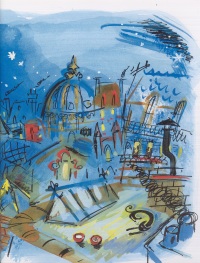| ________________
CM . . . . Volume XVI Number 41. . . .June 25, 2010. 
 |
Paris in the Spring with Picasso.
Joan Yolleck. Illustrated by Marjorie Priceman.
New York, NY: Schwartz & Wade Books (Distributed in Canada by Random House of Canada),
2010.
32 pp., hardcover, $22.99.
ISBN 978-0-375-83756-2.
Subject Headings:
Paris (France)-History-1870-1940-Juvenile fiction.
Paris (France)-Intellectual life-20th century-Juvenile fiction.
Kindergarten-grade 8 / Ages 5-13.
Review by Ann Stinner.
****/4
|
| |
|

Paris in the Spring with Picasso, written by Joan Yolleck and illustrated by Marjorie Priceman, is a large format, hardcover story book which revolves around a lively, but fictional, spring day in Paris early in the twentieth century. Although the events are made up by the author, they are inspired by the actual lives of some of the artists and writers who really lived in Paris at that time: Pablo Picasso, Gertrude and Leo Stein, Alice B. Toklas, Max Jacob, Guillaume Apollinaire and Marie Laurencin.
Early on in the book, we read that
Every Saturday, no matter what the season, Gertrude and Leo hold a soiree, an evening party. Friends come for dinner and then, at around nine o'clock, the house is opened to anyone who might like to visit.
Mais attendez, wait! We're getting ahead of ourselves. It's still early and Gertrude's friends are just beginning their day. How will they spend it? Shall we visit with them and see?
 This short passage introduces the central premise of the story. The delightful narrative focuses on fictitious but plausible events leading up to a soiree hosted by Gertrude and Leo for their bohemian friends on an evening in Paris sometime in the early years of the twentieth century. The characters to which we will be introduced are all historical figures: writer Gertrude Stein and her brother, Leo; Gertrude's companion Alice B. Toklas, cook and cookbook writer; painter Pablo Picasso and his lady of the moment, Fernande; Max Jacob, the poet, painter, writer and critic; and Guillaume Apollinaire, poet, playwright and critic, and his girlfriend Marie "Coco" Laurencin, another painter. Gertude's soirees in Paris were, in fact, legendary gatherings of an international group of artists, writers and critics whose works were to define the literary and artistic avant garde. This short passage introduces the central premise of the story. The delightful narrative focuses on fictitious but plausible events leading up to a soiree hosted by Gertrude and Leo for their bohemian friends on an evening in Paris sometime in the early years of the twentieth century. The characters to which we will be introduced are all historical figures: writer Gertrude Stein and her brother, Leo; Gertrude's companion Alice B. Toklas, cook and cookbook writer; painter Pablo Picasso and his lady of the moment, Fernande; Max Jacob, the poet, painter, writer and critic; and Guillaume Apollinaire, poet, playwright and critic, and his girlfriend Marie "Coco" Laurencin, another painter. Gertude's soirees in Paris were, in fact, legendary gatherings of an international group of artists, writers and critics whose works were to define the literary and artistic avant garde.
This sample of text also introduces us to the personality of the anonymous narrator of the story. The illustrations support the notion that the narrator is, in fact, the skinny little black cat who often appears in the pictures. S/he is observant, somewhat excitable, and very Parisian, exclaiming in French here and there while leading us confidently through the streets and alleys of the city. In fact, the feline storyteller appears to have his/her own little visual subplot, appearing in several illustrations doing things not mentioned in the text: for example, eavesdropping from behind an umbrella stand or sleeping on a rooftop. Because this charming cat/narrator speaks to us directly, like a friendly tour guide, we are willingly drawn into the story.
The main narration provides entertaining and authentic glimpses into the lives of the central characters as they go about their artistic lives, in language simple enough that even young listeners and viewers can understand the excitement of the various creative enterprises of the characters and the anticipation building up to the party. The illustrations - reminiscent of the painting style of Raoul Dufy, another contemporary - communicate an additional layer of excitement, by conveying through colour, line and layout the effervescent atmosphere of Paris in the years before the First World War. Bright colours are laid on in a washy, spontaneous style; squiggly gestural lines, with lots of curves and diagonals, suggest energy; and the layout of pages and points of view are varied and inventive. A note on the book's cover mentions that the illustrator recently went to Paris to sketch the places depicted in this book. What fun! From the detail in the illustrations - life on the streets, in parks, and in the cafes - as well as the text's vivid descriptions of Parisian landmarks of the time and the characters' daily activities, it is clear that both author and illustrator did substantial research for this book. The result is a book of dynamically integrated text and images which, together, create the impression of a city bursting with creative energy. The endpapers - blue with spatters of yellow, red, black and white - echo this energy.
A special feature of this book is a final "reference" section featuring a framed photo and a few additional anecdotes about each of the main characters. These pages reinforce the fact that the characters in the story were real people and that we can do further research on them. (A small disappointment here: no mention is made of Marie Laurencin. A photo and short bio of her might have reminded readers that there were a few female artists active at the beginning of the twentieth century.)
This book should be of great interest to all readers/viewers from about age 4 up. People of different ages will find different aspects of the book appealing. Very young children will be intrigued by the fact that it is a cat who tells us the story and leads us through the streets and parks of the brightly-coloured city. Older readers will enjoy the narrative and visual details of an artist's life in Paris. Educators could find Paris in the Spring with Picasso supporting their teaching in a number of ways: for example, as a brief historical introduction to artists and writers of the early twentieth century, as an example of writing from a point of view or of painting images of city life. However, this book, with all its charm and boisterous energy, makes this reader simply want to book a flight to Paris immediately!
Highly Recommended.
Ann Stinner is a book artist and former art education instructor in the Faculty of Education at the University of Manitoba.

To comment on this title or this review, send mail to
cm@umanitoba.ca.
Copyright © the Manitoba Library Association. Reproduction for personal use is permitted only if this copyright notice is maintained. Any other reproduction is prohibited without permission.
NEXT REVIEW |
TABLE OF CONTENTS FOR THIS ISSUE- June 25, 2010.
AUTHORS |
TITLES |
MEDIA REVIEWS |
PROFILES |
BACK ISSUES |
SEARCH |
CMARCHIVE |
HOME |

 This short passage introduces the central premise of the story. The delightful narrative focuses on fictitious but plausible events leading up to a soiree hosted by Gertrude and Leo for their bohemian friends on an evening in Paris sometime in the early years of the twentieth century. The characters to which we will be introduced are all historical figures: writer Gertrude Stein and her brother, Leo; Gertrude's companion Alice B. Toklas, cook and cookbook writer; painter Pablo Picasso and his lady of the moment, Fernande; Max Jacob, the poet, painter, writer and critic; and Guillaume Apollinaire, poet, playwright and critic, and his girlfriend Marie "Coco" Laurencin, another painter. Gertude's soirees in Paris were, in fact, legendary gatherings of an international group of artists, writers and critics whose works were to define the literary and artistic avant garde.
This short passage introduces the central premise of the story. The delightful narrative focuses on fictitious but plausible events leading up to a soiree hosted by Gertrude and Leo for their bohemian friends on an evening in Paris sometime in the early years of the twentieth century. The characters to which we will be introduced are all historical figures: writer Gertrude Stein and her brother, Leo; Gertrude's companion Alice B. Toklas, cook and cookbook writer; painter Pablo Picasso and his lady of the moment, Fernande; Max Jacob, the poet, painter, writer and critic; and Guillaume Apollinaire, poet, playwright and critic, and his girlfriend Marie "Coco" Laurencin, another painter. Gertude's soirees in Paris were, in fact, legendary gatherings of an international group of artists, writers and critics whose works were to define the literary and artistic avant garde.